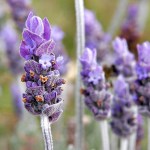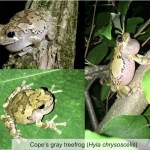Image of lavender fromGFDL 1.2, https://commons.wikimedia.org/w/index.php?curid=322384
While lavender aromatherapy has been documented to reduce stress in humans, little is known about its potential for reducing stress in veterinary medicine. Horses can develop elevated heart rates and stress hormone levels when they are confined to horse trailers and transported to new competition venues. Therapies to reduce stress in competition horses are regulated and often prohibit the use of sedatives or oral supplements. Kylie Heitman, an undergraduate student at Albion College, was interested…

Image from Pete Markham via Flickr Creative Commons (https://flic.kr/p/8ctqVC)
Researchers at the University of Cambridge in Britain recently studied 'willpower' in pet Labrador retrievers. After allowing each dog to smell a hot dog, the researchers placed the hot dog in a hamster cage and sealed it shut with duct tape. While some dogs showed only mild interest in the sealed-up hot dog, others were fixated on the out-of-reach treat. One dog, named Ash, broke apart the contraption to obtain the treat. This is interesting because although Ash is not obese or overweight, he…
Have you ever heard of 'Goodpasture Syndrome'? I'll admit I haven't. Check out the award-winning video below for the 2017 American Physiological Society's video contest to learn about this syndrome. The video was created by Melissa Traver, Samantha Lyons, and Andrianna Walsh from Centenary College of Louisiana. Congratulations!!
Antibiotic-resistant bacteria are a pretty scary thing, which is why researchers are working so hard to come up with new and creative ways to fight them off. Take for example nanosponges.
In a presentation from the Experimental Biology meeting in Chicago last month, researchers from the University of California in San Diego are testing the use of nanosponges (shown on the right in the figure below) to bind and inactivate toxins that are released from bacteria.
Image Credit: Tamara Escajadillo, University of California, San Diego
Nanosponges are basically the membrane of red blood…
Front view of a star-nosed mole. Credit: Ken Catania
Dr. Kenneth Catania from Vanderbilt University presented his work with star-nosed moles at the Experimental Biology meeting last month in Chicago. These animals are really cool. Here are some facts from Dr. Catania about these crazy-looking creatures you may not know:
If participating in a bug-eating contest, they would win hands down every time because they are the fastest-eating mammal known. In fact, they can identify and consume a bug in a record less than two tenths of a millisecond. This is possible…
A team of researchers at Children's Hospital at Philadelphia are working to develop an artificial womb that they hope will help human babies born prematurely to develop normally. They are testing this amazing technology in premature lambs. Here is a video from Tech Insider that was posted to YouTube:
Dr. Clara do Amaral is a postdoctoral fellow at the University of Dayton in Ohio where she studies freeze tolerance in frogs. She received a Research Recognition Award from the Comparative and Evolutionary Physiology section of the American Physiological Society at the 2017 Experimental Biology meeting in Chicago, IL. She prepared this award-winning guest blog entry to describe her interesting research:
The Cope’s gray treefrog is a small frog that occurs in the eastern United States. You can find it sitting on the trunks and branches of trees, and you can hear it calling from the…
Here are the highlights from the final day of the meeting:
Carbon monoxide (CO) is not all that bad: Michael Tift, graduate student at Scripps Institute of Oceanography, described how the body naturally produces CO when red blood cells are broken down and CO can actually be protective against inflammation at low doses. His research was focused on measuring whether species that have more hemoglobin (from living in hypoxic environments) also have more CO. As it turns out, people native to high-altitude Peru do have higher CO levels than those living at lower elevations. Likewise,…
Thank you Dr. Barb Goodman (Director of SD Biomedical Research Infrastructure Network, Fellow of the American Physiological Society, Sanford School of Medicine of the University of South Dakota) who sent me information about thirsty koalas.
Koalas typically hydrate themselves from the leaves of eucalyptus trees. But recently researchers at the University of Sydney have noticed the animals are drinking water as eucalyptus trees have succumbed to wildfires and climate change. Koalas have found a friend in Robert Frend, who is a farmer in New South Wales and creator of "Blinky Drinker",…
The August Krogh Distinguished lecture was awarded to Dr. Warren Burggren, who gave a fantastic lecture on epigenetics, or modifications to gene expression. He discussed how epigenetic changes to our genes are reversible. So when a stimulus like hypoxia changes our genes, these epigenetic changes to the genes go away rather quickly when the hypoxic insult is gone, which contrasts genetic mutations that arise from modifications to the genetic code leading to relatively permanent changes.
Highlights from today's sessions included:
Norelia Ordonez-Castillo, undergraduate student from Fort Hays State University, presented her research on channel catfish. According to Norelia, these fish can become obese so her research was geared towards trying to find out how their receptor for LDL cholesterol differs from rodents and humans. But what I want to know is whether the obese catfish tastes better...
Image of channel catfish by Ryan Somma via Wikimedia Commons
Christine Schwartz, Investigator from University of Wisconsin-La Crosse, studied how the brain of hibernating…
Yesterday was a great day for comparative physiology!
Highlights from the seminars on comparative physiology:
Melissa Reiterer, graduate student from Florida Atlantic University, presented her research on how freshwater turtles (Trachemys scripta) survive for long periods of time without oxygen and do not develop oxidative stress after oxygen is restored. The turtles are able to do this by creating their own antioxidants as well as eliminating oxidative stress. In contrast, mammals including humans, develop quite a bit of oxidative stress following a stroke as…
Day 1 of the meeting was as inspiring as usual.
The Porter Fellow Reunion Reception took place this evening. This 50 year-old program is designed to support trainees as they conduct research projects in physiology and learn to become independent researchers. It was amazing to see so many past and present fellows and to hear about their accomplishments since receiving the award.
Following the Porter reception, I moseyed on over to the Walter B. Cannon memorial lecture. This year's recipient of the award is Dr. Michael Welsh from the University of…
Image of a Komodo dragon By Charlesjsharp - Own work, from Sharp Photography, sharpphotography, CC BY-SA 4.0, via Wikimedia Commons
Researchers at George Mason University have created a synthetic version of a peptide found in the blood of Komodo dragons (Varanus komodoensis). They dubbed the synthetic peptide DRGN-1. Living up to its name, DRGN-1 proved to be pretty tough against microbes (Pseudomonas aeruginosa and Staphylococcus aureus) as well as biofilms. Bacteria stick together to create biofilms that attach to surfaces and help to protect…
Image of an obese rhesus monkey at a zoo in Japan. Image from Daily Mail.
A new study published in American Journal of Physiology - Endocrinology and Metabolism shows that rhesus monkeys (Macaca mulatta) who spontaneously develop obesity with aging are prone to insulin resistance and diabetes, similar to humans. The major goal of insulin is to lower blood sugar after eating a meal. In line with this goal, muscles respond to insulin by taking up large amounts of the sugar. Similarly, insulin blocks the breakdown of glucose as well as production of new glucose in the…
The 2017 Experimental Biology conference is almost here!
Here are some of this year's highlights:
Dr. Michael Welsh from the Howard Hughes Medical Institute and University of Iowa will be presenting the Walter B. Cannon Award Lecture. He will be speaking about Cystic Fibrosis.
This year's Nobel lecture in Physiology or Medicine will be given by Laureate Dr. Louis J Ignarro who, along with Drs. Robert Furchgott and Ferid Murad, won the prize in 1998 for discovering how nitric oxide works in the cardiovascular system.
I am also looking forward to the many comparative…
Dopamine is an important hormone released from neurons involved in reward pathways. Researchers at Cornell University wanted to know if dopamine signaling was involved in how birds learn songs. Their findings, recently published in Science, present evidence that neurons in the brain of zebra finches do in fact decrease dopamine signals when the birds hear an error in their song in comparison to when they sing 'correctly'. The researchers also found that dopamine signaling was enhanced when the birds corrected a mistake made during a prior attempt.
Sources:
V. Gadagkar…
A new article published in Physiological Reviews compared some remarkable similarities and differences between naked mole rats and humans. Both are relatively long-lived, highly social and have low natural selection pressures. But, this is about all they have in common. While humans are prone to developing age-related cancer, diabetes, heart disease and dementias, naked mole rats are rather resistant to these diseases. Instead, naked mole rats appear to maintain a youthful state throughout their long lives of 30+ years, compared to a mere 3 years for a mouse. To top it off, they do not…
Image of Rana dybowski by Pierre Fidenci, via Wikimedia Commons
Leptin is a hormone that signals the brain to suppress appetite in humans. While researchers at the University of Michigan described a similar appetite regulating role for leptin in South African clawed frogs (Xenopus), they also discovered that leptin signals limb development in tadpoles. They suspect that this happens once there are sufficient energy stores to begin the process of metamorphosis. Shalitin and Kiess (2017) also described a role for leptin in skeletal development of …
A new study shows that globally, spiders consume 400-800 million tons of prey each year. That's roughly more than double the amount of fish and meat that humans consume. Impressive...yet creepy at the same time. I suppose we should thank them for their pest control efforts.
Sources:
M Nyffeler, K Birkhofer. An estimated 400–800 million tons of prey are annually killed by the global spider community. The Science of Nature. 104: 30, 2017. doi:10.1007/s00114-017-1440-1
News Beat video from YouTube


